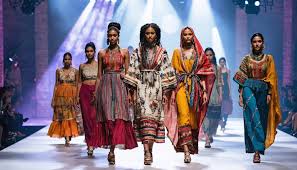Fashion is more than just clothing—it is a reflection of identity, heritage, and the times we live in. In our increasingly interconnected world, cultural influences in fashion have become more prominent, blurring the lines between tradition and modernity. From African prints on haute couture runways to Japanese kimonos influencing contemporary streetwear, the global fashion landscape …
Cultural Influences in Fashion: How Tradition Meets Modern Style

Fashion is more than just clothing—it is a reflection of identity, heritage, and the times we live in. In our increasingly interconnected world, cultural influences in fashion have become more prominent, blurring the lines between tradition and modernity. From African prints on haute couture runways to Japanese kimonos influencing contemporary streetwear, the global fashion landscape is a tapestry woven with threads from diverse cultures.
So how does tradition meet modern style? Let’s unravel the fascinating journey of cultural expression in the world of fashion.
The Roots of Fashion: A Cultural Inheritance
Cultural fashion originates from centuries-old traditions, rituals, and lifestyles of communities around the world. These styles are steeped in symbolism and often reflect societal values, religious beliefs, and historical experiences.
Traditional Styles with Global Appeal
- Japanese Kimono: Once strictly ceremonial, now adapted in high fashion with modern cuts and fabrics.
- Indian Sari: A symbol of grace and tradition, reimagined by designers for evening gowns and fusion wear.
- African Prints (Ankara & Kente): Celebrated for vibrant colors and patterns, now a staple in streetwear and high fashion.
- Scottish Tartan: Originally clan-specific, now a universal motif in punk fashion and luxury design.
These traditional garments are not just decorative; they tell stories and preserve the essence of the cultures they come from.
Globalization and the Evolution of Style
The digital age and globalization have accelerated the blending of cultures. Social media, international travel, and the internet have exposed people to a vast array of cultural aesthetics, allowing for cross-cultural inspiration and collaboration.
Fashion Without Borders
- Designers are increasingly drawing on cultural elements from across the globe.
- Models, influencers, and consumers are embracing diverse styles that celebrate heritage.
- Collaborations between global brands and local artisans foster cultural appreciation and innovation.
For instance, fashion powerhouses like Dior and Gucci have incorporated African and Asian influences into their collections, not merely for aesthetic appeal but also to acknowledge the richness of those cultures.
Modernizing Tradition: The Art of Fusion
The real magic happens when designers respectfully reinterpret traditional styles for the modern era. This fusion creates something entirely new while still honoring its origins.
Notable Examples:
- Sabyasachi Mukherjee: Known for modernizing Indian bridal wear with vintage western elements.
- Vivienne Tam: Blends Chinese motifs with Western silhouettes.
- Stella Jean: An Italian-Haitian designer who merges Italian tailoring with Caribbean patterns.
Street Style and Subcultures
In urban fashion, young designers frequently mix traditional fabrics with contemporary silhouettes, like bomber jackets made from Indonesian batik or sneakers featuring Native American beadwork.
The Ethics of Cultural Representation
With the rise of cultural fusion in fashion comes the responsibility to navigate the thin line between appreciation and appropriation.
Cultural Appropriation vs. Cultural Appreciation
- Appropriation involves using cultural elements without understanding or respecting their significance.
- Appreciation involves collaboration, acknowledgment, and ethical sourcing.
Designers and brands must prioritize respectful engagement:
- Work with artisans and communities.
- Understand the meaning behind symbols and garments.
- Provide fair compensation and credit.
A successful example is the collaboration between luxury brand Loewe and artisans from Colombia, which resulted in bags inspired by Wayuu weaving, produced with the direct involvement of the community.
Cultural Identity and Personal Style
Today, fashion has become a medium for expressing one’s heritage and individuality. Many individuals from multicultural backgrounds use fashion to celebrate their roots and blend them with their personal taste.
Diaspora and Dual Identity
For people in the diaspora, combining traditional and modern clothing is a powerful statement of identity:
- Wearing a Nigerian gele (headwrap) with a Western suit.
- Combining a Chinese cheongsam top with denim jeans.
- Styling hijabs with high-fashion accessories.
These style choices create a sense of pride and belonging while challenging monolithic beauty standards.
Technology, Sustainability, and Cultural Fashion
Technological advancements and the growing demand for sustainable fashion have also influenced how traditional styles evolve.
Digital Revival of Heritage
- Digital printing enables ancient motifs to be reproduced on modern textiles.
- Virtual try-ons allow designers to reach global audiences without waste.
Sustainability Through Tradition
Many traditional practices promote slow fashion:
- Handloom weaving
- Natural dyeing
- Artisan embroidery
By integrating these methods into modern collections, designers champion sustainability while preserving cultural heritage.
The Future of Cultural Fashion
As the fashion industry becomes more inclusive and aware, the trend of blending cultural influences is only expected to grow. The next wave of designers is likely to:
- Explore their heritage and integrate it into innovative fashion.
- Use storytelling to add depth to designs.
- Focus on ethical partnerships with cultural communities.
Fashion education is also evolving to include discussions about cultural sensitivity and responsible design, equipping future designers with tools to engage with tradition thoughtfully.
Conclusion
In the ever-evolving world of fashion, tradition and modernity are not opposites but collaborators. Cultural influences enrich the fashion landscape, providing designers with endless inspiration and consumers with a deeper connection to global narratives.
By embracing heritage and innovation simultaneously, we move toward a fashion future that is not only stylish but also respectful, inclusive, and meaningful.
“Style is a way to say who you are without having to speak” — and in today’s world, it often speaks of a blend of tradition and modernity, stitched together with cultural pride.




